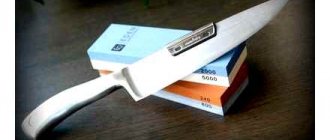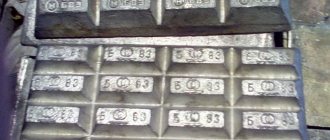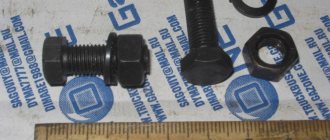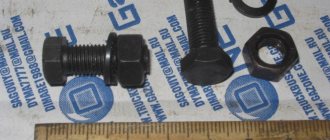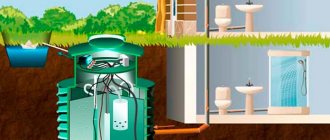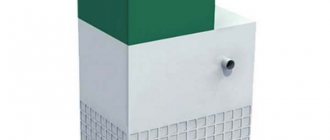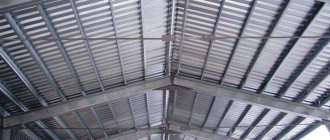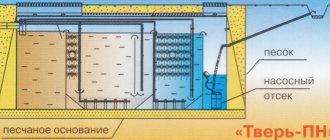How to work correctly with a Fokina flat cutter
Some gardeners become dissatisfied after working with the tool, since many do not know how to work correctly with a Fokin flat cutter.
As a rule, skills in working with other garden tools are also applied when using a flat cutter. When working with a flat cutter, there is no need to bend over; you need to stand straight, holding the tool like a scythe.
Loosening the soil
Did you know?
At the beginning of the 20th century, Ivan Ovsinsky increased productivity several times without applying mineral fertilizers, using surface loosening and without removing straw from the ground.
Loosening and weeding is carried out with the wide side of the blade - it enters the soil at the optimal distance (about 5 cm) and with a slight movement is pulled towards itself or along the bed. In this case, the tool resembles a scythe. The soil should not be raked, but remain in place, loosened.
Important! The blade should enter the ground at a slight angle with the sharp end, almost parallel to the surface, and not from above and flat.
Thus, with the help of a Fokin flat cutter, knowing how to work with it, you can process unsown beds, potato, tomato, cucumber and cabbage rows.
Formation of ridges
Another function that a flat cutter can perform is the formation of beds.
Moving along one side, on the other they rake soil and cut weeds onto the bed. Having walked along one side in this way, they move to the other and rake up the bed from the other edge. The edges of the bed should remain parallel and straight. In wet areas, the beds are made higher, using a flat cutter to perform intermittent, jerky movements, throwing soil onto the bed.
The width for subsequent work with a large Fokin flat cutter should remain optimal - 1 m.
Grooving
To level the furrows, the blade is buried flat to a depth of 1-2 cm. The flat cutter is driven like a rake, along the bed towards you smoothly or with slight acceleration. At the same time, the lumps are loosened and the beds are leveled.
Important! If this operation is carried out, each time moving along the north side (so that the slope of the bed is directed to the south), you can grow vegetables at an earlier date.
Hilling up plants
The next process that this tool will make easier is hilling. How does the Fokin flat cutter work in this case? The wide part of the blade is lowered to a shallow depth into the ground. Afterwards, the soil is fluffed up with gentle movements.
They work as a tool on the principle of a hoe.
Weed removal
When loosening the soil and forming beds, young weeds are destroyed almost completely (70-80%). If these operations are carried out at intervals of 7-10 days, then the weeds can be completely destroyed.
However, if you are late with processing, you will have to use a flat cutter to remove weeds. How to use a Fokin flat cutter to correctly carry out the procedure for ridding our crops of wild relatives? It's simple: the blade of the tool is smoothly inserted to a depth of 1-3 cm (the soil should be moderately moist).
If the ground is dry, the grown weeds are cut with a sharp movement of a flat cutter or according to the principle of a scythe with the blade deepened by 1-3 cm.
After a week, the operation should be repeated to remove the weeds that have taken root. In any case, the Fokina flat cutter (of course, if you know how to use it) will eliminate the need to collect weeds from the garden bed.
What can be done with a flat cutter
- Loosen the soil and weed the beds
. The wide part of the blade is used for this job. You need to bury the cutting part into the soil at a distance of about a meter from yourself and pull it towards you. In order for the work to be as efficient as possible, it is important not to miss the moment, weeding the grass when it has just risen and has not gained full strength.
- Form ridges.
To do this, the soil from the rows is moved to a bed marked and prepared for planting, and the sides are covered with an inverted flat cutter. It is directed with the short cutting edge downwards, and then pulled towards itself, while the earth is raked to the desired place. A similar action is performed alternately on both sides.
- Level the soil on the ridges.
You can level a bed with a flat cutter by lowering the tool with the cutting part onto the bed and dragging it along the surface, without putting any effort into deepening. The seeds sown in the furrows are also planted.
- Perform deep loosening.
To do this, you need to make impact movements on the ground with a narrow cutting edge, plunging it the entire length deep into the soil.
- Make furrows for sowing seeds or planting seedlings.
Having stuck the flat cutter with its narrow edge into the loosened soil to the desired depth, it is pulled in the transverse direction of the ridge, making a planting furrow. If you need to sow seeds, you can use a small flat cutter; it is better to form furrows for seedlings with a large one.
- Hill up the plantings.
Hilling is carried out in the same way as beds are formed - the soil is raked up to the plant from both sides.
- Thin out thickened crops.
Vegetable crops such as carrots or parsley often require thinning of emerging plants. It is carried out using a small flat cutter - it is passed across the rows, thus removing excess shoots.
- Distribute organic
fertilizers
over the entire surface of the beds.
We answer the skeptics
The Fokina flat cutter has been in use among Russian summer residents and villagers with estates for more than two decades, but debate about its usefulness and effectiveness is still ongoing. Those who do not have the patience to master a flat cutter, to learn how to use it correctly in order to appreciate all the benefits, are against its use. They give a variety of reasons to justify their position. We will list below the most common complaints and criticisms and try to respond to opponents.
You can often hear from them that a flat cutter is an extra tool, that for every type of garden work, hoes, rakes, forks, shovels and scythes have been used for a long time, and in our time a lot of special small-sized equipment has been added to the gardener’s arsenal, which perfectly processes areas of any size . But not everyone can afford to purchase a lot of tools and equipment, and they are of no use if you only have about 10 acres of land. The Fokina flat cutter was created for processing relatively small areas; it solves two problems at once - it replaces a whole list of tools and does not allow you to get tired quickly, rationally distributing physical effort when working in the garden. It is difficult to do without it even when you need to cultivate narrow row spacing, box beds, and flower beds with perennials. It is difficult to solve this problem using other tools.
A number of opponents are convinced that the use of a flat cutter when cultivating the land leads to the dominance of weeds on the site. They believe that weed seeds lying on the ground should, when digging up the area with a shovel, fall into the lower layers of the soil, where they will lose their germination. If you don’t dig up the area, they will inevitably germinate all of them. This judgment is wrong. Digging does not interfere with the germination of weed seeds. Consider quinoa, for example. In one summer season, three types of seeds are obtained from it - some are full-fledged, ready to germinate already in the current season, others will sprout next spring, and the lion's share will wait in the wings in the soil, maintaining germination for 10 years. Digging up the area with a shovel, we pull these deep-seeds “out into the light of day,” where they germinate safely. By cultivating the soil with a flat cutter, you can kill weeds. It is necessary to trim the rising grass about once a week, destroying the above-ground part of the weeds. This tool allows you to do such work easily and quickly. In the absence of the above-ground part, most of the roots of weeds will die. And cut grass will improve the structure of the soil, saturate it with organic matter and minerals.
Opponents of the flat cutter do not let up and insist that by working with this tool, we cut the root system of especially malicious perennial weeds into many separate segments, each of which produces a new plant. In fact, everything is not like that. The roots of weedy perennials, ready for reproduction, are located at a depth of 5-10 cm, while the flat cutter, when loosening, goes deep only 2-5 cm.
As we have already said, soil cultivation with a flat cutter, performed as an alternative to conventional digging, is of a non-moldboard nature. Agricultural technicians have recognized that non-moldboard preparation of soil for planting preserves all microorganisms beneficial to it. Proponents of digging up the soil with a shovel to a bayonet depth argue that if you do this when the soil is well heated, you cannot harm the vital activity of microorganisms beneficial to the earth. We think it's better to use a flat cutter. And this is not just a matter of the temperature of different layers of the soil. Oxygen also plays a huge role. Aerobic microorganisms for which it is vitally necessary live closer to the soil surface. With their help, plant residues are processed into compounds useful for the soil. Anaerobes live in its lower layers - they also contribute to the fertility of the earth. So oxygen is destructive to these anaerobic microorganisms. When digging with a shovel, layers of earth are turned out, and as a result, both aerobes and anaerobes die. When processed with a flat cutter, they continue their vital activity beneficial to the soil.
Tool characteristics
The flat cutter includes several garden tools in its design (small shovel, rake, scythe and others). This versatile equipment allows you to perform a significant number of different gardening tasks. Working with a hoe saves physical effort and time.
- The shape of the tool is a metal plate bent in a specific way, the three edges of which are sharpened. There is a choice on the market between a large and a small flat cutter. The first is intended for shaping, hilling the bed, as well as for getting rid of weeds or mowing grass. The second facilitates the work of weeding or forming furrows for sowing.
- The main feature is the ability to remove weeds using a blade. The tool destroys unwanted grass without turning over the soil, which preserves the soil structure and beneficial microorganisms. The roots of the weeds remain in the soil and rot.
- Before you start using the equipment, you should individually adjust it to your height and working style, and also understand the capabilities and scope of action. When assembling the flat cutter, you need to screw two fasteners to the wooden handle.
Making a Fokin flat cutter with your own hands to facilitate manual labor is a worthwhile idea. Every gardener will enjoy cultivating the soil quickly and efficiently using a flat cutter. Now loosening the soil and exterminating weeds will be a simple matter, and the yield of noble crops will be much higher.
The manufacturing process of a flat cutter.
The first stage was the tempering of the metal.
- He heated it in the flame of a blowtorch to cherry color and left it to cool in the air.
- I used a grinder to sharpen the edge of the blade for the cutting knife.
- Drilled holes for mounting to the handle. It’s a bit difficult, but at low drill speeds the process is easy.
- I drew lines with chalk where there should be bends, according to Fokin’s drawing.
- I secured the released torsion bar sheet in a vice slightly above the bend line and, heating the bend with a blowtorch, bent the sheet to the appropriate degree with an adjustable wrench. It is necessary to bend easily, without force, and it is necessary to ensure that cracks or splinters do not form. When heated, the metal becomes malleable.
- The following bends were made in a similar way.
- The most important moment comes during hardening. The burner flame from the blowtorch was directed along the blade of the flat cutter and heated to a cherry color. Don't overheat.
- Holding the edge with large carpenter's pliers, I lowered the hot blade into automobile oil for one or two seconds. I held it in the air for two or three seconds and lowered it into the oil again. Do this until the oil stops boiling on the canvas. Over-exposure will not do any good. The canvas breaks easily (tested).
The second Fokin flat cutter was made without heat treatment and it turned out to be no worse and just as resistant to loads
Moreover, it retains elasticity to bends, which is important when loosening the soil.
The handle to the flat knife was made flat, according to the description of the designer Fokin. Convenient to hold the flat cutter when processing and turning in the bed. Reminds me of the childhood feeling of a hockey stick.
I don’t know about others, but I prefer my flat cutter for processing my garden. It does not strain your back and the processing speed is much higher. The Fokina flat cutter is convenient for me in small beds and I use it for weeding onions, parsley, and young shoots of table greens.
Advantages of a flat cutter
Despite its simplicity, the Fokina flat cutter is a fairly functional tool that has many advantages over other garden tools.
- In organic farming, the usual digging of soil is replaced by cultivating the area with a flat cutter. This saves time, energy costs and only brings benefits. The thing is that when cultivating the soil with a flat cutter, the layers of soil do not turn over. This allows you to preserve the structure of the earth and all microorganisms, which significantly increases productivity.
- Working with a Fokin flat cutter is not at all difficult. Even a pensioner can do this.
- With this tool, weeds are destroyed and turned into fertilizer. With constant cultivation, their roots are left to rot in the ground.
Thus, the benefits of the Fokin flat cutter are obvious. One tool helps perform up to 30 types of work.
They can easily remove weeds, loosen the soil, hill up beds, cut grooves for sowing seeds and clean livestock buildings. You can do all this without effort and back pain!
From their own experience, many gardeners have noticed that the use of a flat cutter increases the fertility of the land, the crop ripens several weeks ahead of schedule, and the plants are less susceptible to disease.
Application
In other words, how to use it correctly so as not to get tired and have time to do everything. What's the main thing in the garden beds? So that the back is unloaded, the knees do not hurt, and the work brings aesthetic pleasure.
And for this we determine the type of soil, since clayey, hard areas cannot be easily processed even with such a tool. Before starting work, be sure to sharpen the flat cutter.
Flat cutters are suitable for:
- Preparing already dug up land for planting seeds and seedlings.
- Making holes and longitudinal grooves.
- Thinning growing vegetable crops.
- Weeding.
- Hilling up.
- Tall weed cuttings.
- Stripping garden trunks for whitewashing.
Where can I buy an original Fokin flat cutter?
Only a flat cutter made according to the inventor’s patterns will be able to give you true pleasure in dacha work. No other options, even homemade ones made exactly according to drawings, can boast of durability and reliability simply because steel processing and anti-corrosion coating technologies are constantly being improved.
Real flat cutters “from Fokin” are necessarily sold with the inventor’s brochure “To the Earth with Science”, with a color cover and a photograph of V.V. Fokina. The kit includes 2 attachments (large - for tillage and complex work, small - for quick and easy weeding), a set of fasteners and 2 cuttings. You can make cuttings for flat cutters yourself; at the end of the brochure there are instructions on how to do this.
You can contact one of the leading manufacturers, which preserves and enhances the traditions laid down by the inventor Fokin, in the following ways:
Mailing address:
601384, Vladimir region, Sudogodsky district, Muromtsevo village, st. Shkurina, 8, apt. 6.Fokin Vladislav Olegovich.
+7,
+7.
Detailed information for online ordering of Fokina flat cutters is here.
What it is?
The flat cutter was invented and patented by an outstanding and versatile person, a talented journalist, engineer and gardener, Vladimir Vasilyevich Fokin from the city of Sudogda, Vladimir region. The idea of creating a tool came to him after he suffered a heart attack, as a result of which full-time work in the garden was out of the question. The author began to study the behavior of hand-held agricultural tools in certain conditions and analyze their strengths and weaknesses. After a series of experiments with various variations, Vladimir Vasilyevich came to the creation of a device that was completely unique in its simplicity and effectiveness, which was later called a flat cutter, and was successfully tested on his own personal plot. Today, the production of flat cutters is carried out by the workshop founded by Vladimir Vasilyevich, which is located in his homeland - in the city of Sudogda, and produces the best tool in Russia.
Structurally, a flat cutter is a curved metal bracket attached to a long handle, and looks like a poker. Each side is sharpened, which significantly reduces soil resistance during operation and greatly facilitates manual labor. There are also combined models consisting of two blades of different lengths. The secret to the effectiveness of the tool lies in the combination of its geometric shapes with the size of the angles on the bends of the structure. This allows for flat cutting of the soil without plunging particularly deeply into it. From the outside, working with a flat cutter looks like sweeping snow with a broom in both directions, which is due to the double-edged blade of the tool and the ability to perform manipulations in either direction.
History of invention
Designed an innovative garden tool by V.V. Fokin is a man who has tried himself in a variety of guises. He also had experience working as a designer at a machine-building plant, but then Vladimir Vasilyevich moved to the countryside, became interested in gardening, became interested in the problems of agricultural technology, and grew vegetables on his own plot.
He was prompted to invent a flat cutter by a sad event - Vladimir Vasilyevich suffered a massive heart attack, and after that there was no question of returning to his previous physical activity - doctors strictly prohibited intense physical activity. But Fokin was not going to put up with this, nor was he going to give up growing homemade, organic vegetables in the garden. He decided to come up with a tool that would allow him to do work in the garden quickly, without putting in excessive effort. By this time, the inventor was already retired against his will, so he took up the matter with enthusiasm, which he later infected his entire family with.
But obtaining a patent was still a long way off. Work on the flat cutter dragged on for several years until it acquired the appearance that is now known not only to Russian summer residents, but also to gardeners in the CIS countries and abroad. First, the inventor showed the new tool to his relatives and friends, and Vladimir Vasilyevich’s neighbors also tried to work with it. And the flat cutter was highly rated by everyone. Only after this Fokin patented his invention and launched the production of the innovative instrument. In 2002, Vladimir Vasilyevich died, but the flat cutter he invented is still in high demand among gardening enthusiasts and makes their hard work easier.
Unlike a conventional hoe, the Fokin flat cutter can perform a variety of types of work; it can replace a whole range of gardening tools. However, there are many people who were not able to use the full potential of the Fokin flat cutter. Some lacked knowledge, others lacked patience. When starting to use any new tool, conclusions about its advantages and disadvantages can be drawn only after you have developed certain operating skills. This concerns the Fokin flat cutter to a greater extent than any other tool. You need to prepare to work with it, adjust it in accordance with your height, learn how to change the adjustment parameters of the cutting part depending on the type of work being performed. Only then will you be able to fully exploit the potential inherent in the design of this invention.
Fokina combined flat cutter, modernized
Types of flat cutters and their application
All work in the garden and vegetable garden can be performed by one of those proposed in the list. But then the principle of using this tool – easily and efficiently – will be violated.
A flat cutter will help, but on the condition that each model will be used for its intended purpose.
- Small flat cutter - for working on light soil, when forming furrows and small beds, for sowing vegetable seeds, weeding and fine loosening.
- Large – formation of large ridges and seeding furrows on heavy soils. Planting crops using seedling method. Loosening to a depth of more than ten centimeters. Formation of tree trunk circles, first hilling of plants in the early phases of growth.
- Small wedge – quick processing of narrow row spacing. The working part of the tool is narrow, sharply sharpened.
- A large weed is a tool with a strong, sharp blade for weeding crops that occupy large areas.
- Moguschnik – has the widest blade, convenient for hilling vegetable crops.
- Strong - a wide but short blade allows you to process heavy, rocky soils.
To process one crop, in different growth phases, it is possible to use different models. If a Small Flat Cutter is suitable for planting carrot or beet seeds, then in the future, for weeding and loosening the rows of these same crops, you will need a large or small Polotik.
Points to consider:
The stalk should be rectangular with rounded edges. The cutting should “fit” in your hand. When gripping, the fingers should “look” up. If the diameter of the handle is large, it will be difficult to work with such a tool. The length of the cutting is selected according to the height of the person. A short handle will force you to work while bending over, while a long handle will not allow you to hold the tool at the required angle. The metal part is attached to the handle at an angle of 45°. Industrial models have ready-made technical holes
This point is important to consider when making a flat cutter yourself. The tool must be well sharpened. It is easier to work with a sharp tool.
The main principle is the horizontal direction of movement of the tool at a given depth. In this case, both rules will be observed: work will be easy, and the quality and speed of work will be high.
Safety precautions at work
The first question after purchasing a Fokin flat cutter is: how can it work effectively? First of all, you should forget about traumatic bends, body tilts and sudden movements. The rules of use are simple: a straight back without the need to load the spine and lower back.
With a minimum of effort, a sharpened blade will ensure a small penetration of a few centimeters into the soil, and the gardener is left with a smooth “sweeping” from side to side, being in the plane of the surface soil. It should be remembered that it is not necessary to rework and drill the entire length of the spade bayonet. And understanding what to do and what angle to choose in a particular case will come with practice.
Best (but not only) uses :
- loosening and weeding already discussed;
- design of beds, when the flat side acts as a bucket for raking the earth in the desired direction;
- leveling the soil and filling the sown holes;
- preparing furrows with a narrow end;
- deep loosening - it is carried out by hitting the ground with a flat cutter raised to chest level, while its own weight is superimposed on the given acceleration;
- crushing earth clods with a blunt sole;
- haymaking (measuring the strength and size of the proposed field) and turning the compost;
- hilling and many others.
How to use a Fokin flat cutter correctly
The Fokin flat cutter can rightfully be considered a replacement for many country tools, for example:
- hoe;
- cultivator;
- plow;
- hoe;
- hiller.
This device partially replaces a scythe, rake, shovel and fork. The tool is suitable for the following work on the site:
- Formation of beds. This type of work is the most important stage. The Fokina flat cutter perfectly forms beds. First, use the reverse side of the device to rake the soil between the rows onto the main ridge, one at a time, first from one row-spacing, then from the other. The edge of the blade should be perpendicular to the surface of the bed, looking down. The flat cutter should be moved smoothly towards you, raking the earth into one place.
- Leveling the surface of the beds. The Fokina double flat cutter is perfect for performing such work. The edges of the tool must be buried 1-2 cm into the ground and the tool must be guided like a rake. Additionally, soil lumps are loosened.
- Loosening and weeding. The sharp cutting edge of the tool makes it easy to deal with weeds. The flat cutter should be directed towards you, smoothly burying it into the ground. By performing these steps, you can easily remove weeds, especially in the early stages of their growth and development. You can get rid of various types of weeds using the method of simply mowing the top layer of soil;
- Processing clay soil. If there is a need to process heavy, clayey soil, you need to use a tool in the same way as a pickaxe or ketman. A sharp blade is buried into the ground with its narrowed end and parts of the block are broken off. Experienced summer residents often note that they should not dig up the site to great depths. The required depth should not be more than a few centimeters. This requires striking the soil with the narrow cutting side. Such work can be carried out with any flat cutter, but it is best to use the “Strong” and “Powerful”;
- Hilling. It is best to carry out hilling using the “Power” model. The soil located between the rows is sprinkled with an inverted tool on each side of the plants;
- Soil cracking. Using this tool, you can easily loosen the soil and saturate the soil with oxygen. To carry out this procedure, the narrow edge of the tool should be driven into the ground, as far as the length of the flat cutter allows, and drawn along the ridge. In this way, you can cut grooves for sowing seeds.
Summer garden work using a flat cutter is clearly demonstrated in the video at the end of the article.
Watch the video! Fokina flat cutter, techniques for working with a flat cutter
The main principle of working with a flat cutter is that it must be directed parallel to the surface of the earth; often this rule is not followed.
https://www.youtube.com/watch?v=ntwv9FfBc7Y
When working with the device invented by Fokin, the following conditions must be met:
The back should be kept straight, the body should be slightly inclined; When the handle is in your hands, your thumbs should “look” up; The instrument must be configured correctly. The holes located on the handle of the Large device are used to adjust it to the height of the user. If the setting is carried out correctly, the working person does not have to bend specially, and the device does not get stuck in the ground; An ordinary, round handle does not fit the blade of this device
A special, flat handle is required, on which a specific place is provided for attaching the blade, offset by 45 degrees; It is important to place the beds correctly. They should not be wide; the rows should be separated by paths.
Advantages and disadvantages of a flat cutter
A simple and unpretentious tool has certain advantages.
- Constant use of the equipment will increase the fertility of the soil, which will remain moderately moist, saturated with oxygen and nutrients.
- Ease of use allows you to discard most gardening tools. Working with a flat cutter does not cause pain in the back and joints.
- By changing the angle of inclination of the metal plate, the gardener is able to perform a variety of work for which specific tools were previously used.
- A small flat cutter helps in cultivating hard-to-reach areas of the garden.
- Caring for the equipment does not require much effort: only periodic sharpening is necessary.
The disadvantages of a flat cutter are as follows:
- This multipurpose tool is not capable of digging planting holes or cutting hay. It will not cope with large areas of land densely overgrown with weeds.
- It is problematic to replace a hoe with a flat cutter. Specific tools are better suited for this.
On a note! The cutting part, which is often directed toward the surface of the earth, should be sharpened; burrs should only be removed from the opposite edge. When using electric emery, minimal pressure is required, since hardness and reliability decrease as the temperature of the metal increases.
Necessary materials
In order to be able to independently produce various types of products useful for cultivating the garden, it is advisable to have the most necessary and frequently used materials on hand. Materials that should be in any workshop are, first of all, steel.
The more profiles, strips, rods and steel pipes there are on the farm, the easier it will be to carry out various works, carry out repairs and produce useful equipment.
Also, you definitely need a welding machine, with which you can quickly and reliably connect all metal parts.
This can also be done using metal screws, but their scope of application and reliability are not comparable to welding.
How to sharpen a Fokin flat cutter correctly?
Any gardener knows that all gardening tools must be sharp.
And the Fokina flat cutter is no exception. The sharper the better - these are generally accepted concepts about sharpening tools. However, a lot of jobs are performed with a Fokin hand flat cutter, and sharp sharpening is not needed for every job. For example:
During the first weeding, when the weeds are still very small and are still in the “thread” stage, it is better not to sharpen the flat cutter. It will simply pull them out of the ground, just have time to clear the blade from the stuck thin roots with a blunt flat cutter; you can remove only small weeds in the aisles. A little less sharpness of the blade is needed when cutting grooves for sowing seeds, slotting, thinning densely sown carrots, parsley, dill if the weeds are already have become stronger, then a dull flat cutter cannot cope with them
The blade will have to be sharpened well, and then you will see the result; mowing weeds, cultivating the soil to a depth of up to 5 cm (Ovsinsky style) and deeper (especially along the entire length of the knife) is more convenient with a sharper flat cutter; a sharp blade is necessary when the weeds are already quite large; thinning raspberries, trimming the mustache on strawberries, forming ridges, hilling, of course, better with a sharp blade; for all other work, the blade must be well sharpened, since the flat cutter is most often used when weeding. Attention! One of the main reasons for the inconvenience when working with this tool lies in its improper sharpening, since many people try to sharpen the blade of a flat cutter in the same way as the rest of the tool, which is strictly prohibited.
Sharpening technology
First, a little theory from Fokin:
A flat cutter is not a knife; its cutting edge (chamfer-bevel) should be at an angle of 40-45 °, not sharper. Moreover, cultivating harder ground requires a more obtuse angle.
In practice, to sharpen a flat cutter, you can use any sharpening tool: a file, a whetstone, an electric sharpener, a sharpener-scraper.
If the gardening tool is original from Fokin and not a fake, then it is advisable to sharpen it without overheating the metal.
Note! If the blade is made too sharp, it will easily stick into the ground, but pulling it out will be much more difficult. And one more important point: which side to sharpen on?
And one more important point: which side to sharpen on?
Take a close look at the Fokin flat cutter, it has:
the main cutting edge (the earth “crawls” along it when the tool moves in the soil
and a chamfer-bevel (the back surface, which is turned towards the ground (when working, it faces a stationary monolith of the earth).
You only need to grind the chamfer-bevel, which sharpens the cutting edge, and from the top you just need to remove the burrs with a file.
The flat cutter is ground along the entire length of the blade, maintaining the above specified angle.
If, contrary to common sense, you grind down the front surface of the cutting edge, then the angle of sharpness of the blade becomes larger, and therefore blunter.
Basically, the tip formed by the intersection of the main cutting edge (the longest) and the auxiliary one - at the tip of the blade, wears out, especially if the soil is heavy and rocky.
And so we repeat once again that improper sharpening can only ruin a flat cutter, therefore:
- sharpen the chamfer located on the back surface of the blade. If you do the opposite and grind down the front of the blade, it will become even duller;
- The tip of the flat cutter is always the most worn. It is sharpened first;
- When sharpening, the cutting edge should not heat up. Otherwise, wear resistance is reduced;
- the flat cutter is sharpened at an angle of 45 degrees;
- per season, the tool is sharpened according to all the rules 2 times. For this operation you need an emery wheel, a file, a sharpening stone or a sharpening knife;
- You should always have a universal sharpener on hand, for example a “Scraper Sharpener”, in case you have to run it over the blade several times to make it sharper.
- The blade must be sharpened regularly, without allowing it to become completely dull.
- For winter storage, the tool must be lubricated with something; this will protect the metal from rust. Then next spring the work will go quickly and easily.
PWatch how to sharpen a Fokina flat cutter, Sharpener-scraper, video - better than any story:
Watch how to sharpen a Fokin flat cutter using an emery wheel video - better than any story:
Sharpening and caring for a flat cutter
Despite all the unpretentiousness and wear resistance of the Fokin flat cutter, seasonal inspection should not be neglected. In a situation where it is necessary to renew the sharpness of the blade, a file, emery or a sharpening wheel are equally suitable. Wiring should be carried out from tip to base, measuring by eye an angle of forty-five degrees. An owner who cares about his things will not be too lazy to treat a freshly sharpened flat cutter with an anti-corrosion agent for the winter, then the tool will last longer.
When performing the same procedure with electrical equipment, it is necessary to take into account, among other things, the minimum pressure that does not cause overheating with the inevitable decrease in strength.
Do-it-yourself Fokina flat cutter: step-by-step instructions with drawings
When making a Fokin flat cutter with your own hands, you should adhere to the drawings and instructions as much as possible - this will help preserve the ergonomic properties and technological qualities of the product.
In addition to metal and wood, to make a flat cutter you will need:
- electric drill;
- hammer;
- blowtorch;
- machine oil – treatment (for hardening and anti-corrosion treatment);
- vice;
- pliers and two keys 10 x 12;
- Bulgarian;
- grinder;
- whetstone;
- sandpaper;
- plane;
- bolts, washers and nuts.
Workpiece manufacturing process
A piece of ordinary iron is cut to the required size. When using high-alloy steel, it should be taken into account that the workpiece will be both hard and brittle.
Before further processing, the steel must be “tempered”. To do this you need:
heat the workpiece evenly along its entire length with a blowtorch (gasoline or gas) until it acquires a cherry color (it is important not to overheat; if it starts to turn orange, it is already overheating); After making sure that the workpiece has become cherry color, leave it to cool. It is better to carry out such processing in the summer or in a warm room - cooling will be more uniform. After the workpiece has completely cooled down, you can already make a flat cutter with your own hands
Having cut off the required length with a grinder, you can proceed to the next stage - marking according to the drawing (where to drill holes, where to bend)
After the workpiece has completely cooled, you can make a flat cutter with your own hands. Having cut off the required length with a grinder, you can proceed to the next stage - marking according to the drawing (where to drill holes, where to bend).
Workpiece deformation
The stage of deforming the workpiece is important because it is necessary to give the desired shape and maintain the angles. The workpiece should be clamped in a vice and using a hammer, bend the metal according to the marks (the bends can be preheated with a blowtorch):
- the first bend should have an angle of 95-105 degrees;
- second – 110-130 degrees;
- the third bend is similar to the second;
- the last, fourth bend is made within the same limits, adjusting the workpiece to the handle.
The deformation sequence cannot be changed (otherwise the last fold will not work). Thus, we will obtain a blank of the so-called large Fokin flat cutter, in which the blade dimensions are 170 mm.
Transformation of the workpiece and sharpening of the flat cutter
The last stage is drilling holes, giving the final shape, sharpening and hardening. Drilling holes does not cause any problems.
The final shape is given according to the drawing using a sharpening machine and an angle grinder. Using a grinder, the edge of the working part of the flat cutter, including the end, is cut at an angle of 45 degrees. The further effectiveness of its work depends on how to sharpen the Fokin flat cutter - correctly or not.
The sharpening is double-edged (both edges are sharpened, including the end of the blade). It is best to sharpen it on a sharpening machine; you can trim it with a hand sharpener. You should start sharpening from the tip of the flat cutter. After this, it is subjected to hardening (you can do without it, but the flat cutter will become dull faster).
Hardening is carried out as follows:
- pour processing oil into the container (so that when immersed, the workpiece is completely covered with it);
- Use a blowtorch to heat the workpiece evenly (until cherry color);
- quickly immerse it in oil for 2-3 seconds, remove it and after 5 seconds immerse it again, then remove it again and immerse it again (repeat until the oil stops boiling on contact with metal);
- hang to cool. The surface of the workpiece should turn black (protection against corrosion), the metal acquires greater strength.
Making cuttings
Before you make a cutting with your own hands, you need to decide on the material (we have already done this) and the workpiece. The blank for the cutting should be in the form of a rectangular strip 45 mm wide and 20 mm thick.
First you need to give it the necessary shape (it is somewhat reminiscent of a hockey stick):
The assembled handle for the Fokina flat cutter, if placed vertically, should be 20 cm below the shoulder, so the dimensions of the handle for each will be different, individual.
Making a flat cutter with your own hands
Manufacturing is not a complicated process. First you need to select the material for the plate and handle. It must have increased wear resistance. The inventor used 65 G steel, which is difficult to process but lasts a long time.
For cuttings, use pine, birch or ash. You will need a hammer, electric drill, pliers, grinder, sharpening stones, a vice and a blowtorch. During manufacturing, you must adhere to the drawings and explanations , which will preserve the properties of the equipment .
- The steel must be heated evenly until red hot and allowed to cool. Now you can cut the required length with a grinder and mark it.
- Clamping the workpiece in a vice, it is given a specific shape using a hammer and soldering iron.
- Drilling holes, sharpening and hardening is the last stage of creation.
- Having chosen the material for the handle, you need to process four sides with a plane and sandpaper. Next, mark the space for the holes, where the flat cutter and handle will be connected using fasteners.
An original device created by inventor V.V. Fokin facilitates work in garden plots and allows you to save health and time. There are six types of flat cutters, which are intended for a specific type of activity on the site.
When purchasing products, you need to know the signs of the original and counterfeit versions.
How to make a Fokina flat cutter at home
Making it yourself will not be difficult.
Before you start work you need to decide:
- what types of work, in what volumes and on what soils are planned to be carried out;
- what material is available for the work;
- what tools does the master have;
- how many flat cutters need to be made.
After preparing everything you need, you can start working. By doing everything step by step, you can achieve good results and get a simple but useful tool.
Selecting metal for a flat cutter
The main part of the flat cutter is the metal part. How long you can choose the right metal, the more durable the tool will be. For production you will need a strip 4 - 4.5 cm wide and 40 -45 cm long.
What will suit the metal part:
- steel angle sawn lengthwise;
- car spring, 5-7 mm thick.
High-alloy steel is the best option. Tools made from this material are durable, resistant to corrosion and do not require frequent sharpening.
It is advisable to choose a stronger metal. In order to make it more pliable in processing, it is “released”. Having heated the plate on a blowtorch to the color of a ripe cherry, it is allowed to cool slowly. This “tempering” procedure will allow you to bend, drill and sharpen the workpiece in accordance with the product diagram.
Making a flat cutter blank
If the steel is high-alloy, for ease of working with it, it must first be “released”. After this procedure, the metal will be more pliable and easier to work with.
The entire process of manufacturing a flat cutter can be divided into several stages:
- We give the workpiece the required shape in accordance with the dimensions.
- Let's mark the detail.
- We mark the locations of the technical holes and the places where the plate bends.
It is convenient to bend the plate by holding it in a vice. It is better to preheat the areas of the plate where bends are planned.
Using precise blows of a hammer, give the plate the required angles:
- The first fold should be 90 – 100 degrees;
- second – 110˚ – 120˚;
- third – 110˚ – 120˚;
- the fourth fold is adjusted to the junction with the handle.
It is better to bend the plate in this sequence, otherwise it will be very difficult to make the fourth fold. This is how all models of flat cutters are made, the only difference is the width and length of the segments between the folds of the product. You need to bend the metal slowly, periodically checking the angle with that indicated in the drawing. Avoid bending and reverse actions - this may break the bend and the workpiece will have to be thrown away.
In accordance with the diagram, technical holes are marked and drilled. They should be located at a distance of 5 - 7 mm from the edge of the workpiece. The diameter of the holes depends on the width of the plate, the number of mounting bolts and the model of the flat cutter.
Assembly diagram of a flat cutter
To manufacture and assemble a flat cutter you will need the following tools:
- electric knife with replaceable circles;
- drill with a set of drills;
- vice;
- large and medium hammer;
- blowtorch;
- plane;
- sandpaper.
The handle for the flat cutter should not be round. A rectangular blank with rounded edges is easier to hold in the hand and makes the fastening unit for the metal part strong and reliable.
If you have the material, a detailed drawing and the necessary tools, it will take 3 to 4 hours to make the tool. You can use it for more than one season. A self-made flat cutter will make all work in the garden easier and will be a source of pride for the master.


